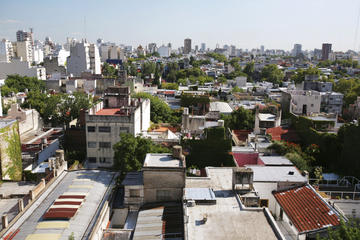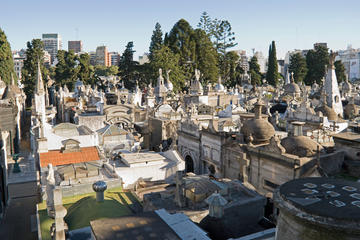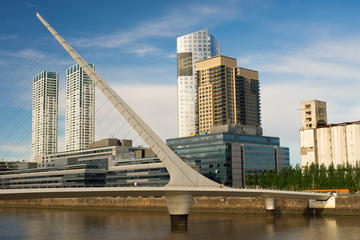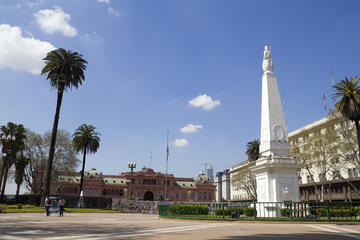*The ritzy Recoleta neighborhood draws visitors in the numbers for a wander through Buenos Aires’ up-market residential streets and public parks.
For most visitors, the main attraction is the Recoleta Cemetery, an ornate necropolis so large it’s like a mini city of states and marble sarcophagi. One of the most famous tombs is that of Eva Peron (Evita).
The enclave also attracts thousands of people for its weekend crafts market, held on Plaza Francia outside the Basílica de Nuestra Señora del Pilar.
Museums and art galleries, lovely plazas and parklands are another feature of Recoleta.
2.)Palermo:

*Buenos Aires’ largest barrio, the northern district of Palermo encompasses a number of city hotspots, favored by the city’s most cosmopolitan and fashionable residents. The ever-trendy Palermo Soho and Palermo Hollywood make up the old quarter of Palermo Viejo where grand residential buildings jostle for space with quirky boutiques and some of the city’s finest bars, restaurants and nightclubs.
Palermo is also renowned for its parks and there are plenty of idyllic green spaces to choose from. The tree-lined Bosques of Palermo is a hugely popular picnic spot centered around a glistening lake and the family-friendly Zoological Gardens are surrounded by the lush Botanical gardens, Japanese gardens, the Evita Museum and the Galileo Galilei planetarium. Close by, the Palermo Hippodrome is situated next door to the legendary Campo de Polo sports ground, and the iconic Floralis Genérica art installation stands proud over the Plaza de las Naciones Unidas. Further south, the exclusive Palermo Chico neighborhood is a tranquil pocket of elegant mansions and private villas flanking the celebrated MALBA (Museo de Arte Latinoamericano) art museum and bordering Recoleta.
3.)Recoleta Cemetery:

*While it may seem odd that one of Buenos Aires’ principal tourist attractions is a cemetery, the Recoleta Cemetery is no ordinary graveyard. Encircled by a towering perimeter wall and entered via a striking columned portico, Recoleta Cemetery is one of the world’s most exquisite necropolises; a glorious ‘City of the Dead’ that houses some of the country’s most prominent political, military and artistic icons.
Over 6,400 tombs are found in the Cemetery, laid out in formal tree-lined avenues and punctuated with beautifully sculpted monuments, poignant marble statutes and grand, bronze-cast mausoleums. Notable burial plots include the vivid white stone tomb of newspaper founder José C. Paz, flanked by a pair of dazzling Rubenesque angels; the ostentatious tomb of former Argentine president Carlos Pellegrini, featuring an elaborate statue of the controversial leader atop the coffin; and the evocative statues of crying widows kneeling beside the tomb of Colonel Falcon, the Chief of Police famously assassinated by rebels in 1909. One of the most visited tombs is that of the city’s beloved Eva Perón, or Evita, whose family vault blooms year-round with bunches of fresh flowers and is inscribed with the promise: ‘I will return and be millions!’
With a list of residents that reads like a who’s who of Buenos Aires’ high society, the cemetery serves not only as a resting place for the dead but as a testament to the golden age of Buenos Aires and the equally turbulent and triumphant history of Argentina. One thing’s for sure – the ornate miniature city with its breathtaking sculptures and fine works of art is a fitting tribute to everyone buried there.
4.) Puerto Madero/ Puerto Madero Bridge

*Once a lackluster cargo port, the waterfront area of Puerto Madero is now one of Buenos Aires’ most fashionable districts, teeming with upmarket restaurants and glitzy nightclubs. Marooned from the mainland by the Rio de la Plata estuary, the largely pedestrianized island is celebrated for housing some of the city’s most architecturally stunning buildings. Luxury apartments, plush hotels and high-rise office towers dominate the area, encircling a stylish waterfront plaza and backed by an expanse of naturally preserved parkland.
The barrio’s pièce de résistance is the iconic Puente de la Mujer, or the Woman’s Bridge, an artistic swing-bridge that connects Puerto Madero to the mainland hub of Plaza de Mayo. The futuristic design by Spanish sculpture Santiago Calatrava, is said to symbolize an abstract tango dance and casts a striking silhouette on the city skyline.
As nightfall arrives, the twinkling lights of Puerto Madero make an atmospheric place to spend the evening with an array of gourmet eateries and cocktail bars lining the waterfront, along with a popular cinema and a number of the city’s trendiest dance clubs.
While drinking, dining and dancing are the main reasons to frequent Puerto Madero, the neighboring Costanera Sur Ecological Reserve is the perfect place to alleviate a hangover. An 864-acre expanse of government maintained greenery, the park is as popular among picnicking office workers as it is with weekend cyclists, hikers and birdwatchers. Another perfect way to spend a leisurely afternoon is exploring the Sarmiento and Uruguay - two former naval ships anchored in the harbor that have now been converted into museums.
5.)Plaza de Mayo:

*
Plaza de Mayo is Buenos Aires’ political heart, first mapped out in 1580. Today, the grassy, treed plaza attracts visitors with cameras and relaxing locals, and is also the venue for rallies and gatherings.
The center of the plaza features an obelisk called the Pirámide de Mayo, erected to commemorate independence from Spain.
Grand 19th century buildings line the plaza, but the colonial arches that once circled the plaza are long gone.
Nearby are the city council buildings known as the Cabildo, the Casa Rosada government buildings and fine bank buildings.
No comments:
Post a Comment